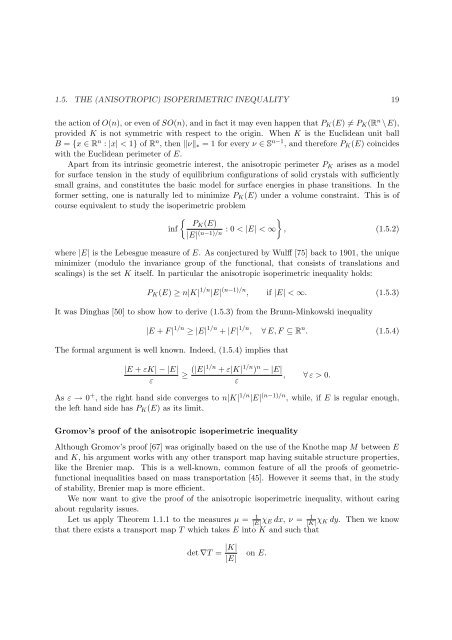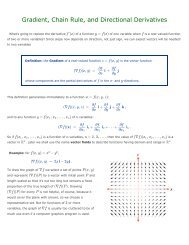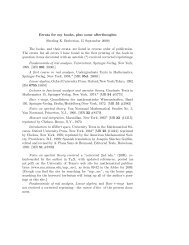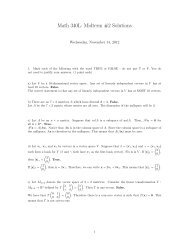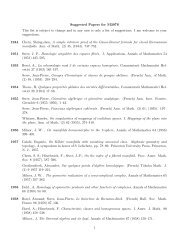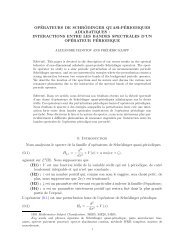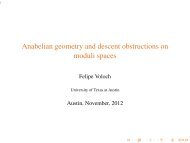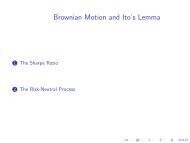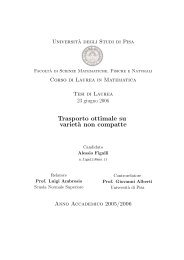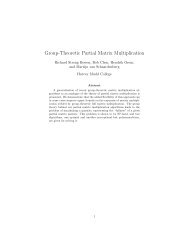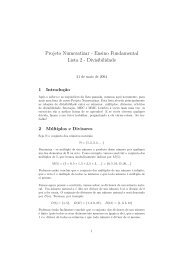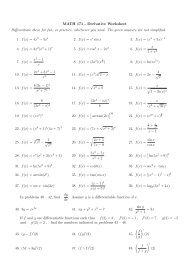Optimal transport, Euler equations, Mather and DiPerna-Lions theories
Optimal transport, Euler equations, Mather and DiPerna-Lions theories
Optimal transport, Euler equations, Mather and DiPerna-Lions theories
Create successful ePaper yourself
Turn your PDF publications into a flip-book with our unique Google optimized e-Paper software.
1.5. THE (ANISOTROPIC) ISOPERIMETRIC INEQUALITY 19<br />
the action of O(n), or even of SO(n), <strong>and</strong> in fact it may even happen that PK(E) = PK(Rn \E),<br />
provided K is not symmetric with respect to the origin. When K is the Euclidean unit ball<br />
B = {x ∈ Rn : |x| < 1} of Rn , then ν∗ = 1 for every ν ∈ Sn−1 , <strong>and</strong> therefore PK(E) coincides<br />
with the Euclidean perimeter of E.<br />
Apart from its intrinsic geometric interest, the anisotropic perimeter PK arises as a model<br />
for surface tension in the study of equilibrium configurations of solid crystals with sufficiently<br />
small grains, <strong>and</strong> constitutes the basic model for surface energies in phase transitions. In the<br />
former setting, one is naturally led to minimize PK(E) under a volume constraint. This is of<br />
course equivalent to study the isoperimetric problem<br />
<br />
PK(E)<br />
inf<br />
: 0 < |E| < ∞ , (1.5.2)<br />
|E| (n−1)/n<br />
where |E| is the Lebesgue measure of E. As conjectured by Wulff [75] back to 1901, the unique<br />
minimizer (modulo the invariance group of the functional, that consists of translations <strong>and</strong><br />
scalings) is the set K itself. In particular the anisotropic isoperimetric inequality holds:<br />
PK(E) ≥ n|K| 1/n |E| (n−1)/n , if |E| < ∞. (1.5.3)<br />
It was Dinghas [50] to show how to derive (1.5.3) from the Brunn-Minkowski inequality<br />
|E + F | 1/n ≥ |E| 1/n + |F | 1/n , ∀ E, F ⊆ R n . (1.5.4)<br />
The formal argument is well known. Indeed, (1.5.4) implies that<br />
|E + εK| − |E|<br />
ε<br />
≥ (|E|1/n + ε|K| 1/n ) n − |E|<br />
, ∀ ε > 0.<br />
ε<br />
As ε → 0 + , the right h<strong>and</strong> side converges to n|K| 1/n |E| (n−1)/n , while, if E is regular enough,<br />
the left h<strong>and</strong> side has PK(E) as its limit.<br />
Gromov’s proof of the anisotropic isoperimetric inequality<br />
Although Gromov’s proof [67] was originally based on the use of the Knothe map M between E<br />
<strong>and</strong> K, his argument works with any other <strong>transport</strong> map having suitable structure properties,<br />
like the Brenier map. This is a well-known, common feature of all the proofs of geometricfunctional<br />
inequalities based on mass <strong>transport</strong>ation [45]. However it seems that, in the study<br />
of stability, Brenier map is more efficient.<br />
We now want to give the proof of the anisotropic isoperimetric inequality, without caring<br />
about regularity issues.<br />
Let us apply Theorem 1.1.1 to the measures µ = 1<br />
|E| χE dx, ν = 1<br />
|K| χK dy. Then we know<br />
that there exists a <strong>transport</strong> map T which takes E into K <strong>and</strong> such that<br />
det ∇T = |K|<br />
|E|<br />
on E.


